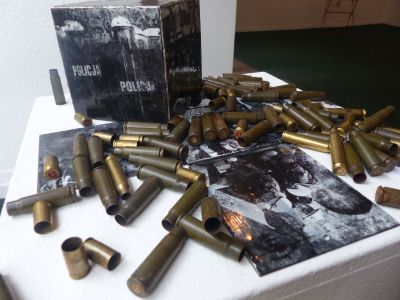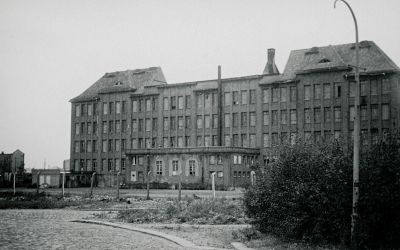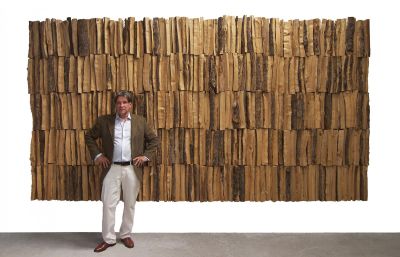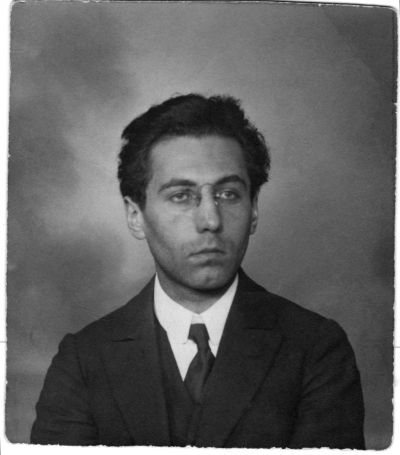“PoKuSa” – gallery for contemporary Polish art in Wiesbaden
Mediathek Sorted

























The seeds for the “PoKuSa” gallery were sown thanks to the passionate commitment and hard work of Sibylle von Oppeln-Bronikowski, who had founded the art gallery “Privatgalerie” in Albrechtstrasse 40 in Wiesbaden in 1996. She managed the gallery by herself for the first five challenging years. However, in time, it became increasingly difficult to balance running the gallery with her daytime job in the Federal Statistical Office. Originally, Sibylle von Oppeln-Bronikowski had no ties with Poland. However, following the success of the exhibition she organised of the Wrocław artist Eugeniusz Józefowski, now a professor at the Academy of Fine Arts in Wrocław, she developed a greater interest in artists from Poland. She quickly found a site for the future gallery. Small, high-ceilinged rooms on the ground floor of a building with large windows, close to the train station, made for an ideal space for her vision. The opening events and exhibitions attracted an increasing number of visitors to the gallery.
Gallery founders
In 2001, Sibylle von Oppeln-Bronikowski handed over the gallery to the “Polnischer Kultursalon” (or “PoKuSa”) association, which had just been founded. She became the association’s chairperson. The founding members, who came from Poland and Germany, had personal and professional connections to the art world and were able to forge important contacts with the Polish art scene. The first curators of the gallery were Ewa Hartmann, Gerhard Fehrer and Barbara Ahlfeldt. Ewa Hartmann, an art teacher from Wrocław, has lived in Wiesbaden since 1987, where she works in an educational institution. She joined the gallery after visiting an opening event for an exhibition by Eugeniusz Józefowski, one of her professors from Wrocław.[1] Barbara Ahlfeldt, who originally came from Warsaw, settled in Wiesbaden after completing her studies at the Academy of Fine Arts in Paris and Rio de Janerio. Gerhard Fehrer, a great music, opera and art enthusiast who died in 2013, developed his relationship with Poland through his Polish wife. As the years went by, the individual members of the association played a more or less active role, depending on their life circumstances. “The people who are active in the Polnischer Kultursalon have professional lives of their own and dedicate a great deal of their free time to promoting Polish art”, Barbara Cöllen, editor of Deutsche Welle, explained in 2009 after visiting Wiesbaden.[2]
For many years, Ewa Hartmann has been supported in her curatorial and organisational work by Elisabeth Springer-Heinze, a physician and artist from Wiesbaden, who now also organises solo exhibitions. Dr. Michael Grus, a respected academic at the Goethe-Haus in Frankfurt, is the treasurer of the gallery and the association, and is responsible for finding sponsors.
The gallery is also supported by its hard-working members of the board. They include Barbara Buss, who collaborates with the “GoEast” film festival in Wiesbaden, and the artist Barbara Ahlfeldt, who acts as artistic adviser to the gallery. The sudden death of Gerhard Fehrer in 2013 was a major loss for the association’s founders. He had not only curated a number of different exhibitions in the “PoKuSa”, but was also actively involved in further developing the city partnership between Wiesbaden and Wrocław; he was a passionate campaigner for art and a close friend. The work of the “PoKuSa” gallery consists of the curation of art shows on the one hand, and the voluntary activities of its members on the other. As Ewa Hartmann explains in an interview with “Porta Polonica”: “I am the curator, the ambassador as it were for Polish artists and art in the city and the region – but the gallery is the entire team! Without the effort put in by all our members, the gallery would not be possible”. For more than 20 years, the “PoKuSa” has not only steadily continued to develop, but has also retained its independence. Today, the association has 30 members , while the community that has grown around it is far larger.
The artists
Right from the start, the “PoKuSa” gallery set the bar very high. It supports young talent and accompanies the artists it shows on their creative journey. Some of them, such as Eugeniusz Józefowski, Norman Smużniak oder Zdzisław Nitka regularly return to Wiesbaden with their new series of works. Norman Smużniak has shown his works seven times since the gallery opened 20 years ago. It says something about the nature of the gallery that today, these artists are professors at the Academy of Fine Arts in Wrocław and that they send their best graduates there. One reflection of the success of “PoKuSa” is that a work by Zdzisław Nitka is now part of the permanent exhibition in the National Museum in Wrocław.
The curator Ewa Hartmann is proud of the gallery’s collaboration with the most talented young artists from important cultural centres in Poland. For the gallery, the most important axes of artistic exchange are the Academy of Fine Arts in Wrocław and the Academy of Fine Arts in Poznań, as well as numerous independent artists from throughout the country. It is no coincidence that young, aspiring artists with international awards choose to show their work in the “PoKuSa”.
Local art collectors also appreciate the “PoKuSa” and the opportunities it provides to acquire works by Polish graphic artists, who are traditionally highly valued abroad. As Ewa Hartmann explains: “People from all over the world come to Wrocław to study graphic arts, which are particularly highly developed at the Academy there”. These days, it can sometimes happen that the most talented students in a year and the ones with the best diploma grades come from other countries and speak no Polish at all. One example is Christoph Nowicki, an American of Polish origin. He first came to the Academy in Wrocław as a student and now works as a professor there. The “PoKuSa” gallery shows his works created using the mezzotint process, a printing technique that is rarely applied today. In the words of Ewa Hartmann: “Graphic techniques are constantly subject to change. Nowadays, screen printing is no longer limited to just paper”. She points to the works on porcelain by Małgorzata Warlikowska such as the “Marilyn jako Trophies” series that was shown in Wiesbaden several years ago. In 2020, as part of the “Breslau Expansion” exhibition, which presented works by the best students from the studio run by Professor M. Warlikowska, Majka Dokudowicz and Joannis Anastasiou showed a metal box with graphic screen printing, printed on metal and fixed with enamel. The screen prints of their work, entitled “Contain Yourself, Sir”, were based on photographs of police violence in different countries throughout the world. At the opening event, the work was further developed into a live performance. At first, the box remained closed; when the artist lifted it up, cartridge cases fell out in huge numbers, and the box assumed the shape of a cross. The outer sides showed the names of the victims of police violence against a black background.
Polish graphic artists are also notable for their love of experimentation. Professor Przemysław Tyszkiewicz, winner of the German Daniel Chodowiecki Prize, showed his unusually large-format aquatint etchings at the “PoKuSa”. The linocuts of Anna Gawlikowska, large 100 x 100 cm portraits interspersed with interesting patterns, also met with an enthusiastic response. Małgorzata Malwina Niespodziewana, who teaches in the faculty of art at the teaching college in Kraków, also attracted a great deal of positive attention for her consistent concepts. As well as a solo exhibition in which she presented two series of her works, her graphic designs, which depict feminist currents in art, were included in several group shows in the “PoKuSa”.
Artists whose output has previously been shown in the gallery enjoy increasing success. The works by Anna Mierzejwska have now also been exhibited in the “Zachęta” gallery in Warsaw, while Małgorzata ET BER Warlikowska is a celebrated international artist who is shown at events such as the Ljubljana Biennale. Often, Warlikowska focuses on feminist themes. At the Academy of Fine Arts in Wrocław, she is a professor for screen printing, a technique that combines text, drawing and photography in different layers. Her “Brudne sny” (“Dirty dreams”) series, which looks at the sex appeal of Marilyn Monroe, caused quite a stir in Wiesbaden. Regular visitors to exhibitions at the “PoKuSa” also remember Katarzyna Kukuła’s humorous erotic works, her artistic nudes, and her drawings — “Na węglu” (“On coal”) or “W malinach” (“In raspberries”) from the “Kamasutra po polsku” (“Kama Sutra in Polish”) series.
Barbara Ahlfeldt had an equally important curatorial influence on the activities of the “PoKuSa”. In 2005, under her aegis, Monika Krajewska presented her Jewish-inspired Mizrahi cutouts, while Hanna Rojkowska showed painting with motifs from Jewish culture. The city of Poznań was represented in Wiesbaden by Jarosław Łukasik, who some years later also presented another series of his works in the “PoKuSa”, and also by Małgorzata Andrzejewska with a colourful, enchanting series showing hillsides with vineyards.
Polish artists from Germany
The gallery space is also used by Polish artists based in Germany. Magda Klemm, originally from Warsaw and now living in Berlin, already exhibited her work here during the early years after the gallery opened. At that time, the exhibition was curated by the painter Barbara Ahlfeldt, who in 2003 presented her own works that border on surrealism. Karl-Karol Chrobok, who graduated from the Academy of Fine Arts in Kraków, showed paintings that stood out for their dense layer of colour and at the same time their sharp lines and contours. Ewa Stefanski, a graduate of the Academy of Fine Arts in Poznań, who has lived in Frankfurt/Main since 1981, is among the artists who most frequently show their works at the “PoKuSa”. The very first exhibition there in 2001 was dedicated to her. 17 years later, her work was the subject of the 100th exhibition in the gallery.[1] The photographer Maciej Rusinek, also from Frankfurt/Main, enjoys an increasing degree of international recognition and is also shown at the “PoKuSa”. The majority of his photographs portray dance theatre, particularly Japanese butoh theatre. Works have also been shown by Alicja Horbowa, who lives near Frankfurt, and the painter and sculptor Artur Bart (“Bartosik”), a graduate of the Academy of Fine Arts in Gdańsk, who has lived in the Rhine-Main region since the late 1980s.
The art market
The exhibitions attract the attention of the local media, which emphasise not only the artistic merit of the works, but also the concept behind the exhibitions. The works by an artist couple from Warsaw, the painter Joanna Krzysztoń and the photographer Grzegorz Rogala, were described in the “Wiesbadener Kurier” as “a fascinating exhibition, a gallery cooperation that was a complete success”.[2] During that period, Joanna Krzysztoń presented 40 small-format works that referenced the story of the way of the cross, and which represented the suffering and feeling of all humans, while Grzegorz Rogala depicted authentic episodes from the lives of his subjects in large-format, digitally edited photographs.
For more than 20 years, Ewa Hartmann and her six-person “PoKuSa” team have expanded their network of contacts and have become an important German partner for artists from Poland. The gallery projects are funded by a range of different institutions, which collaborate within the scope of the partnership between the cities of Wiesbaden and Wrocław, or the regions of Hesse and Greater Poland (Wielkopolska). Here, the fact that the “PoKuSa” is capable of self-financing, like every other gallery in the city, is of key importance. This is both a major challenge and a major achievement. When choosing which artists to show, the gallery aims to provide an insight into unusual artworks on the one hand, while at the same time finding buyers for the artists shown. The opening events are extremely popular – so much so that it’s not unusual for more people to turn up than the gallery can hold.
Now, after more than 100 “PoKuSa” exhibitions, several hundred works have found their way into the hands of private collections in Wiesbaden and the surrounding area. The curator Ewa Hartmann and her husband Michael Grus alone now own more than 100 Polish works of art.
The annual pre-Christmas exhibition, “Winterart”, in which the gallery shows a large number of small-format works at affordable prices, has become particularly popular as a counterpoint to the mass consumption during the festive season. Between five and six shows are organised every year. At the opening events, guests have the opportunity to talk with the artists, meet friends and make new contacts. And of course, it’s possible to take home a piece of the exhibition by purchasing one of the works.
Synergies
For several years, the “PoKuSa” gallery has been a valued partner and player when it comes to art events in Wiesbaden. In 2002, the curator Ewa Hartmann, together with the gallerist Reinhard Berg, created the “Wiesbadener Fototage” (“Wiesbaden photography days”), during which various galleries in the city simultaneously showed works by contemporary photographers, at first annually, and now every three years. Ewa Hartmann was a member of the jury for the “Wiesbadener Fototage” until 2015. Participants in the event included well-known photojournalists and photographic artists such as Chris Niedenthal, Tadeusz Rolke, Ryszard Kapuściński, Maciej Osika and students from photography schools across Poland. Two Polish artists have been the recipients of the public award: Agata Wieczorek (2007) and Ol Skoczylas (2011).
In 2007, to mark the 20th anniversary of cooperation between the partner cities of Wrocław and Wiesbaden, the project bureau in the city museum presented works by students of the School of Photography in Wrocław as part of the “Wiesbadener Fototage”.
In 2012, the “PoKuSa” was also one of the main participants in the celebrations to mark the 25th anniversary of the city partnership between Wiesbaden and Wrocław. The initiator and organiser of the show entitled “Der Raum zwischen uns” (“The space between us”) in the Kunsthaus Wiesbaden gallery was Ewa Hartmann, with Professor Norman Smużniak and Professor Katarzyna Koczyńska-Kielan as curators. The exhibition was opened by the heads of the partner cities, by the mayor Wiesbaden, Dr. Helmut Müller, and the mayor of Wrocław, Rafał Dutkiewicz.
The “PoKuSa” brings people together who are interested in cultural exchange between Germany and Poland. The “Deutsch-Polnische Gesellschaft Mainz-Wiesbaden” (“German-Polish Society in Mainz-Wiesbaden”) was active for nearly 30 years until 2022. Other organisations in the area were the “Deutsch-Polnische Verein Wiesbaden-Wrocław e.V.” (“German-Polish Association of Wiesbaden-Wrocław”) and the “Mainzer Polonicum”, which is known for its activities as part of the University of Mainz. The paths of many people in these circles cross in the gallery or at concerts in the city’s main theatre organised within the scope of the city partnership, at events with Polish writers and authors in the “Literaturhaus” in Wiesbaden, or at guest lectures in the Polonicum. The “PoKuSa” also hosts poetry evenings, with readings by Rosemarie Bronikowski, Marek Pelc and Joanna Manc from Frankfurt, among others.
Ambassador of art
At the “PoKuSa”, the artists are always at the forefront. Ewa Hartmann and the members of the association are all volunteers. As well as acting as curator, she is also responsible for the transportation of the artworks, the gallery service during exhibitions, preparation of opening events and cleaning the gallery. Her work also involves having artists to stay in her home, and preparing the exhibition space with them as well as showing them the sights in the city and surrounding area. For many years now, journeys to Poland on gallery business or visits to the art academies and studios there have at the same time been visits to friends who share the same passion. For years, the “PoKuSa” has collaborated with the highly respected “Galeria M” in Wrocław, among others. The head of “Galeria M”, Maria Dziedziniewicz, regularly inspires the artists who exhibit in the gallery and once curated one of the shows herself.
The gallery is known in Wiesbaden for its welcoming, open-minded attitude. The curator Ewa Hartmann knows the value of offering visitors to the gallery an insight into the world of Polish art through face-to-face conversations that are not limited to the opening events. During opening hours, anyone interested in the works will have the opportunity to talk to Ewa Hartmann and the “PoKuSa” team in person. The art events in the gallery attract a large number of regular visitors. Over the course of two decades, the “PoKuSa” has become an ambassador for contemporary Polish art in the region, with the curator Ewa Hartmann and the “PoKuSa” team playing a leading role.
Joanna de Vincenz, October 2022
My thanks to Ewa Hartmann and Barbara Ahlfeldt for providing the detailed information.
Editorial note:
“Pokusa” also literally means “temptation/seduction” in Polish.






















































































